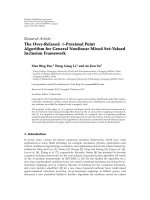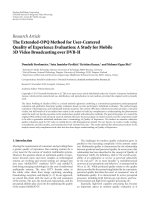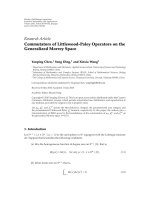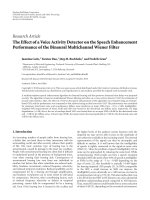Báo cáo hóa học: " Research Article The Best Lower Bound Depended on Two Fixed Variables for Jensen’s Inequality with Ordered Variables" pot
Bạn đang xem bản rút gọn của tài liệu. Xem và tải ngay bản đầy đủ của tài liệu tại đây (492.87 KB, 12 trang )
Hindawi Publishing Corporation
Journal of Inequalities and Applications
Volume 2010, Article ID 128258, 12 pages
doi:10.1155/2010/128258
Research Article
The Best Lower Bound Depended on
Two Fixed Variables for Jensen’s Inequality with
Ordered Variables
Vasile Cirtoaje
Department of Automatic Control and Computers, University of Ploiesti, 100680 Ploiesti, Romania
Correspondence should be addressed to Vasile Cirtoaje,
Received 16 June 2010; Accepted 4 November 2010
Academic Editor: R. N. Mohapatra
Copyright q 2010 Vasile Cirtoaje. This is an open access article distributed under the Creative
Commons Attribution License, which permits unrestricted use, distribution, and reproduction in
any medium, provided the original work is properly cited.
We give the best lower bound for the weighted Jensen’s discrete inequality with ordered variables
applied to a convex function f, in the case when the lower bound depends on f, weights, and two
given variables. Furthermore, under the same conditions, we give some sharp lower bounds for
the weighted AM-GM inequality and AM-HM inequality.
1. Introduction
Let x {x
1
,x
2
, ,x
n
} be a sequence of real numbers belonging to an interval I,andlet
p {p
1
,p
2
, ,p
n
} be a sequence of given positive weights associated to x and satisfying
p
1
p
2
··· p
n
1. If f is a convex function on I, then the well-known discrete Jensen’s
inequality 1 states that
Δ
f, p, x
≥ 0, 1.1
where
Δ
f, p, x
p
1
f
x
1
p
2
f
x
2
··· p
n
f
x
n
− f
p
1
x
1
p
2
x
2
··· p
n
x
n
1.2
is the so-called Jensen’s difference. The next refinement of Jensen’s inequality was proven in
2, as a consequence of its Theorem 2.1,partii
Δ
f, p, x
≥ max
1≤i<k≤n
p
i
f
x
i
p
k
f
x
k
−
p
i
p
k
f
p
i
x
i
p
k
x
k
p
i
p
k
≥ 0. 1.3
2 Journal of Inequalities and Applications
By 1.3, for fixed x
i
and x
k
,weget
Δ
f, p, x
≥ p
i
f
x
i
p
k
f
x
k
−
p
i
p
k
f
p
i
x
i
p
k
x
k
p
i
p
k
: S
p,f
x
i
,x
k
. 1.4
In this paper, we will establish that the best lower bound L
p,f
x
i
,x
k
of Jensen’s difference
Δf, p, x for
x
1
≤···≤x
i
≤···≤x
k
≤···≤x
n
1.5
has the expression
L
p,f
x
i
,x
k
Q
i
f
x
i
R
k
f
x
k
−
Q
i
R
k
f
Q
i
x
i
R
k
x
k
Q
i
R
k
, 1.6
where
Q
i
p
1
p
2
··· p
i
,R
k
p
k
p
k1
··· p
n
. 1.7
Logically, we need to have
L
p,f
x
i
,x
k
≥ S
p,f
x
i
,x
k
. 1.8
Indeed, this inequality is equivalent to Jensen’s inequality
Q
i
− p
i
f
x
i
R
k
− p
k
f
x
k
p
i
p
k
f
p
i
x
i
p
k
x
k
p
i
p
k
≥
Q
i
R
k
f
Q
i
x
i
R
k
x
k
Q
i
R
k
.
1.9
2. Main Results
Theorem 2.1. Let f be a convex function on I, and let x
1
,x
2
, ,x
n
∈ I n ≥ 3 such that
x
1
≤ x
2
≤···≤x
n
. 2.1
For fixed x
i
and x
k
(1 ≤ i<k≤ n), Jensen’s difference Δf, p, x is minimal when
x
1
x
2
··· x
i−1
x
i
,x
k1
x
k2
··· x
n
x
k
,
x
i1
x
i2
··· x
k−1
Q
i
x
i
R
k
x
k
Q
i
R
k
,
2.2
Journal of Inequalities and Applications 3
that is,
Δ
f, p, x
≥ Q
i
f
x
i
R
k
f
x
k
−
Q
i
R
k
f
Q
i
x
i
R
k
x
k
Q
i
R
k
: L
p,f
x
i
,x
k
.
2.3
For proving Theorem 2.1, we will need the following three lemmas.
Lemma 2.2. Let p, q be nonnegative real numbers, and let f be a convex function on I.Ifa, b, c, d ∈ I
such that c, d ∈ a, b and
pa qb pc qd, 2.4
then
pf
a
qf
b
≥ pf
c
qf
d
. 2.5
Lemma 2.3. Let f be a convex function on I, and let x
1
,x
2
, ,x
n
∈ I (n ≥ 3) s uch that
x
1
≤ x
2
≤···≤x
n
. 2.6
For fixed x
i
,x
i1
, ,x
n
,wherei ∈{2, 3, ,n−1}, Jensen’s difference Δf, p, x is minimal when
x
1
x
2
··· x
i−1
x
i
. 2.7
Lemma 2.4. Let f be a convex function on I, and let x
1
,x
2
, ,x
n
∈ I (n ≥ 3) s uch that
x
1
≤ x
2
≤···≤x
n
. 2.8
For fixed x
1
,x
2
, ,x
k
,wherek ∈{2, 3, ,n−1}, Jensen’s difference Δf, p, x is minimal when
x
k1
x
k2
··· x
n
x
k
. 2.9
Applying Theorem 2.1 for fxe
x
and using the substitutions a
1
e
x
1
, a
2
e
x
2
, ,a
n
e
x
n
,weobtain
Corollary 2.5. Let
0 <a
1
≤···≤a
i
≤···≤a
k
≤···≤a
n
, 2.10
and let p
1
,p
2
, ,p
n
be positive real numbers such that p
1
p
2
··· p
n
1. Then,
p
1
a
1
p
2
a
2
··· p
n
a
n
− a
p
1
1
a
p
2
2
···a
p
n
n
≥ Q
i
a
i
R
k
a
k
−
Q
i
R
k
a
Q
i
/Q
i
R
k
i
a
R
k
/Q
i
R
k
k
,
2.11
4 Journal of Inequalities and Applications
with equality for
a
1
a
2
··· a
i
,a
k
a
k1
··· a
n
,
a
i1
a
i2
··· a
k−1
a
Q
i
/Q
i
R
k
i
a
R
k
/Q
i
R
k
k
.
2.12
Using Corollary 2.5, we can prove the propositions below.
Proposition 2.6. Let
0 <a
1
≤···≤a
i
≤···≤a
k
≤···≤a
n
, 2.13
and let p
1
,p
2
, ,p
n
be positive real numbers such that p
1
p
2
··· p
n
1.If
P
⎧
⎪
⎪
⎨
⎪
⎪
⎩
2Q
i
R
k
Q
i
R
k
,Q
i
≤ R
k
,
R
k
,Q
i
≥ R
k
,
2.14
then
p
1
a
1
p
2
a
2
··· p
n
a
n
− a
p
1
1
a
p
2
2
···a
p
n
n
≥ P
√
a
k
−
√
a
i
2
, 2.15
with equality for a
1
a
2
··· a
n
.WhenQ
i
R
k
, equality holds again for a
1
a
2
··· a
i
,
a
i1
··· a
k−1
√
a
i
a
k
, a
k
a
k1
··· a
n
.
Proposition 2.7. Let
0 <a
1
≤···≤a
i
≤···≤a
k
≤···≤a
n
, 2.16
and let p
1
,p
2
, ,p
n
be positive real numbers such that p
1
p
2
··· p
n
1. Then,
p
1
a
1
p
2
a
2
··· p
n
a
n
− a
p
1
1
a
p
2
2
···a
p
n
n
≥
3Q
i
R
k
a
k
− a
i
2
4Q
i
2R
k
a
k
2Q
i
4R
k
a
i
, 2.17
with equality if and only if a
1
a
2
··· a
n
.
Remark 2.8. For p
1
p
2
··· p
n
1/n, from Proposition 2.6 we get the inequality
a
1
a
2
··· a
n
− n
n
√
a
1
a
2
···a
n
≥ P
√
a
k
−
√
a
i
2
, 2.18
where
P
⎧
⎪
⎪
⎨
⎪
⎪
⎩
2i
n − k 1
n i − k 1
,i k ≤ n 1,
n − k 1,i k ≥ n 1.
2.19
Journal of Inequalities and Applications 5
Equality in 2.18 holds for a
1
a
2
··· a
n
.Ifi k n 1, then equality holds again for
a
1
a
2
··· a
i
, a
i1
··· a
k−1
√
a
i
a
k
, a
k
a
k1
··· a
n
.
Remark 2.9. For p
1
p
2
··· p
n
1/n, from Proposition 2.7, we get the inequality
a
1
a
2
··· a
n
− n
n
√
a
1
a
2
···a
n
≥
3i
n − k 1
a
k
− a
i
2
2
n 2i − k 1
a
k
2
2n i − 2k 2
a
i
,
2.20
with equality if and only if a
1
a
2
··· a
n
.
Applying Theorem 2.1 for fx−ln x,weobtain
Corollary 2.10. Let
0 <a
1
≤···≤a
i
≤···≤a
k
≤···≤a
n
, 2.21
and let p
1
,p
2
, ,p
n
be positive real numbers such that p
1
p
2
··· p
n
1. Then,
p
1
a
1
p
2
a
2
··· p
n
a
n
a
p
1
1
a
p
2
2
···a
p
n
n
≥
Q
i
a
i
R
k
a
k
/
Q
i
R
k
Q
i
R
k
a
Q
i
i
a
R
k
k
, 2.22
with equality for
a
1
a
2
··· a
i
,a
k
a
k1
··· a
n
,
a
i1
a
i2
··· a
k−1
Q
i
a
i
R
k
a
k
Q
i
R
k
.
2.23
Remark 2.11. For p
1
p
2
··· p
n
1/n, from Corollary 2.10, we get the inequality
a
1
a
2
··· a
n
n
n
√
a
1
a
2
···a
n
≥
n
ia
i
n − k 1
a
k
/
n i − k 1
ni−k1
a
i
i
a
n−k1
k
, 2.24
with equality for
a
1
a
2
··· a
i
,a
k
a
k1
··· a
n
,
a
i1
a
i2
··· a
k−1
ia
i
n − k 1
a
k
n i − k 1
.
2.25
If i ≤ n/2andk n − i 1, then 2.24 becomes
a
1
a
2
··· a
n
n
n
√
a
1
a
2
···a
n
≥
a
i
/a
n−i1
a
n−i1
/a
i
2
2i/n
, 2.26
6 Journal of Inequalities and Applications
with equality for
a
1
a
2
··· a
i
,a
n−i1
a
n−i2
··· a
n
,
a
i1
a
i2
··· a
n−i
a
i
a
n−i1
2
.
2.27
In the case i 1, from 2.26,weget
a
1
a
2
··· a
n
n
n
√
a
1
a
2
···a
n
≥
a
1
/a
n
a
n
/a
1
2
2/n
, 2.28
with equality for
a
2
a
3
··· a
n−1
a
1
a
n
2
. 2.29
Applying Theorem 2.1 for fx1/x, we obtain the following.
Corollary 2.12. Let
0 <a
1
≤···≤a
i
≤···≤a
k
≤···≤a
n
, 2.30
and let p
1
,p
2
, ,p
n
be positive real numbers such that p
1
p
2
··· p
n
1. Then,
p
1
a
1
p
2
a
2
···
p
n
a
n
−
1
p
1
a
1
p
2
a
2
··· p
n
a
n
≥
Q
i
R
k
a
k
− a
i
2
a
i
a
k
Q
i
a
i
R
k
a
k
, 2.31
with equality for
a
1
a
2
··· a
i
,a
k
a
k1
··· a
n
,
a
i1
a
i2
··· a
k−1
Q
i
a
i
R
k
a
k
Q
i
R
k
.
2.32
Using Corollary 2.12, we can prove the following proposition.
Proposition 2.13. Let
0 <a
1
≤···≤a
i
≤···≤a
k
≤···≤a
n
, 2.33
and let p
1
,p
2
, ,p
n
be positive real numbers such that p
1
p
2
··· p
n
1.If
P
⎧
⎪
⎨
⎪
⎩
Q
i
,Q
i
≤ 3R
k
,
4Q
i
R
k
Q
i
R
k
,Q
i
≥ 3R
k
,
2.34
Journal of Inequalities and Applications 7
then
p
1
a
1
p
2
a
2
···
p
n
a
n
−
1
p
1
a
1
p
2
a
2
··· p
n
a
n
≥ P
1
√
a
i
−
1
√
a
k
2
, 2.35
with equality for a
1
a
2
··· a
n
.
3. Proof of Lemmas
Proof of Lemma 2.2. Since c, d ∈ a, b, there exist λ
1
,λ
2
∈ 0, 1 such that
c λ
1
a
1 − λ
1
b, d λ
2
a
1 − λ
2
b. 3.1
In addition, from pa qb pc qd,weget
qλ
2
1 − λ
1
p. 3.2
Applying Jensen’s inequality twice, we obtain
f
c
f
λ
1
a
1 − λ
1
b
≤ λ
1
f
a
1 − λ
1
f
b
,
f
d
f
λ
2
a
1 − λ
2
b
≤ λ
2
f
a
1 − λ
2
f
b
,
3.3
and hence
pf
c
qf
d
≤ p
λ
1
f
a
1 − λ
1
f
b
q
λ
2
f
a
1 − λ
2
f
b
pf
a
qf
b
.
3.4
Proof of Lemma 2.3. We need to show that
p
1
f
x
1
p
2
f
x
2
··· p
i
f
x
i
− f
p
1
x
1
p
2
x
2
··· p
n
x
n
≥ Q
i
f
x
i
− f
Q
i
x
i
p
i1
x
i1
··· p
n
x
n
.
3.5
Using Jensen’s inequality
p
1
f
x
1
p
2
f
x
2
··· p
i
f
x
i
≥ Q
i
f
p
1
x
1
p
2
x
2
··· p
i
x
i
Q
i
, 3.6
8 Journal of Inequalities and Applications
it suffices to prove that
Q
i
f
p
1
x
1
p
2
x
2
··· p
i
x
i
Q
i
f
Q
i
x
i
p
i1
x
i1
··· p
n
x
n
≥ Q
i
f
x
i
f
p
1
x
1
p
2
x
2
··· p
n
x
n
,
3.7
which can be written as
Q
i
f
X
i
f
Y
i
≥ Q
i
f
x
i
f
X
, 3.8
where
X
i
p
1
x
1
p
2
x
2
··· p
i
x
i
Q
i
,
Y
i
Q
i
x
i
p
i1
x
i1
··· p
n
x
n
,
X p
1
x
1
p
2
x
2
··· p
n
x
n
.
3.9
Since x
i
,X ∈ X
i
,Y
i
and
Q
i
X
i
Y
i
Q
i
x
i
X, 3.10
by Lemma 2.2, the conclusion follows.
Proof of Lemma 2.4. We need to prove that
p
k
f
x
k
p
k1
f
x
k1
··· p
n
f
x
n
− f
p
1
x
1
p
2
x
2
··· p
n
x
n
≥ R
k
f
x
k
− f
p
1
x
1
··· p
k−1
x
k−1
R
k
x
k
.
3.11
By Jensen’s inequality, we have
p
k
f
x
k
p
k1
f
x
k1
··· p
n
f
x
n
≥ R
k
f
p
k
x
k
p
k1
x
k1
··· p
n
x
n
R
k
. 3.12
Therefore, it suffices to prove that
R
k
f
p
k
x
k
p
k1
x
k1
··· p
n
x
n
R
k
f
p
1
x
1
··· p
k−1
x
k−1
R
k
x
k
≥ R
k
f
x
k
f
p
1
x
1
p
2
x
2
··· p
n
x
n
,
3.13
Journal of Inequalities and Applications 9
or, equivalently,
R
k
f
X
k
f
Y
k
≥ R
k
f
x
k
f
X
, 3.14
where
X
k
p
k
x
k
p
k1
x
k1
··· p
n
x
n
R
k
,
Y
k
p
1
x
1
··· p
k−1
x
k−1
R
k
x
k
,
X p
1
x
1
p
2
x
2
··· p
n
x
n
.
3.15
The inequality 3.14 follows from Lemma 2.2,sincex
k
,X ∈ Y
k
,X
k
and
R
k
X
k
Y
k
R
k
x
k
X. 3.16
4. Proof of Theorem
Proof. By Lemmas 2.3 and 2.4, it follows that for fixed x
i
, x
i1
, ,x
k
, Jensen’s difference
Δf, p, x is minimal when x
1
x
2
··· x
i−1
x
i
and x
k1
x
k2
··· x
n
x
k
;
that is,
Δ
f, p, x
≥ Q
i
f
x
i
p
i1
f
x
i1
··· p
k−1
f
x
k−1
R
k
f
x
k
− f
Q
i
x
i
p
i1
x
i1
··· p
k−1
x
k−1
R
k
x
k
.
4.1
Therefore, towards proving 2.3, we only need to show that
p
i1
f
x
i1
··· p
k−1
f
x
k−1
Q
i
R
k
f
Q
i
x
i
R
k
x
k
Q
i
R
k
≥ f
Q
i
x
i
p
i1
x
i1
··· p
k−1
x
k−1
R
k
x
k
.
4.2
Since
Q
i
p
i1
··· p
k−1
R
k
1, 4.3
this inequality is a consequence of Jensen’s inequality. Thus, the proof is completed.
10 Journal of Inequalities and Applications
5. Proof of Propositions
Proof of Proposition 2.6. Using Corollary 2.5, we need to prove that
Q
i
a
i
R
k
a
k
−
Q
i
R
k
a
Q
i
/Q
i
R
k
i
a
R
k
/Q
i
R
k
k
≥ P
√
a
k
−
√
a
i
2
. 5.1
Since this inequality is homogeneous in a
i
and a
k
,andalsoinQ
i
and R
k
, without loss of
generality, assume that a
i
1andQ
i
1. Using the notations a
k
x
2
and R
k
p, where
x ≥ 1andp>0, the inequality is equivalent to gx ≥ 0, where
g
x
1 px
2
−
1 p
x
2p/1p
− P
x − 1
2
, 5.2
with
P
⎧
⎪
⎪
⎨
⎪
⎪
⎩
2p
p 1
,p≥ 1,
p, p ≤ 1.
5.3
We have
g
x
2p
x − x
p−1/p1
− 2P
x − 1
,
g
x
2
p − P
−
2p
p − 1
p 1
x
−2/p1
.
5.4
If p ≥ 1, then
g
x
2p
p − 1
p 1
1 − x
−2/p1
≥ 0, 5.5
and if p ≤ 1, then
g
x
2p
1 − p
p 1
x
−2/p1
≥ 0. 5.6
Since g
x ≥ 0forx ≥ 1, and g
x is increasing, g
x ≥ g10, gx is increasing, and
hence gx ≥ g10forx ≥ 1. This concludes the proof.
Proof of Proposition 2.7. Using Corollary 2.5, we need to prove that
Q
i
a
i
R
k
a
k
−
Q
i
R
k
a
Q
i
/Q
i
R
k
i
a
R
k
/Q
i
R
k
k
≥
3Q
i
R
k
a
k
− a
i
2
4Q
i
2R
k
a
k
2Q
i
4R
k
a
i
.
5.7
Journal of Inequalities and Applications 11
Since this inequality is homogeneous in a
i
and a
k
,andalsoinQ
i
and R
k
, we may set a
i
1
and Q
i
1. Using the notations a
k
x and R
k
p, where x ≥ 1andp>0, the inequality is
equivalent to gx ≥ 0, where
g
x
4 2p
x 2 4p
1 px −
1 p
x
p/1p
− 3p
x − 1
2
. 5.8
We have
1
2
1 2p
g
x
p
x − x
−1/1p
−
2 p
x
p/1p
− 1
,
1 p
2p
1 2p
g
x
1 p x
−2−p/1p
−
2 p
x
−1/1p
,
1 p
2
2p
1 2p
2 p
g
x
x − 1
x
−3−2p/1p
.
5.9
Since g
x ≥ 0forx ≥ 1, g
x is strictly increasing, g
x ≥ g
10, and g
x is strictly
increasing, g
x ≥ g
10, gx is strictly increasing, and hence gx ≥ g10for
x ≥ 1.
Proof of Proposition 2.13. Using Corollary 2.12, we need to prove that
Q
i
R
k
a
k
− a
i
2
a
i
a
k
Q
i
a
i
R
k
a
k
≥ P
1
√
a
i
−
1
√
a
k
2
. 5.10
This inequality is true if
Q
i
R
k
√
a
i
√
a
k
2
≥ P
Q
i
a
i
R
k
a
k
. 5.11
For Q
i
≤ 3R
k
, we have
Q
i
R
k
√
a
i
√
a
k
2
− P
Q
i
a
i
R
k
a
k
Q
i
a
i
2R
k
a
k
a
i
R
k
− Q
i
≥ Q
i
a
i
3R
k
− Q
i
≥ 0.
5.12
Also, for Q
i
≥ 3R
k
,weget
Q
i
R
k
√
a
i
√
a
k
2
− P
Q
i
a
i
R
k
a
k
Q
i
R
k
Q
i
R
k
R
k
− 3Q
i
a
i
Q
i
− 3R
k
a
k
2
Q
i
R
k
√
a
i
a
k
≥
Q
i
R
k
Q
i
R
k
R
k
− 3Q
i
a
i
Q
i
− 3R
k
a
i
2
Q
i
R
k
a
i
0.
5.13
The proposition is proved.
12 Journal of Inequalities and Applications
References
1 D. S. Mitrinovi
´
c, J. E. Pe
ˇ
cari
´
c,andA.M.Fink,Classical and New Inequalities in Analysis, vol. 61 of
Mathematics and Its Applications, Kluwer Academic Publishers, Dordrecht, The Netherlands, 1993.
2 S. S. Dragomir, J. Pe
ˇ
cari
´
c, and L. E. Persson, “Properties of some functionals related to Jensen’s
inequality,” Acta Mathematica Hungarica, vol. 70, no. 1-2, pp. 129–143, 1996.









